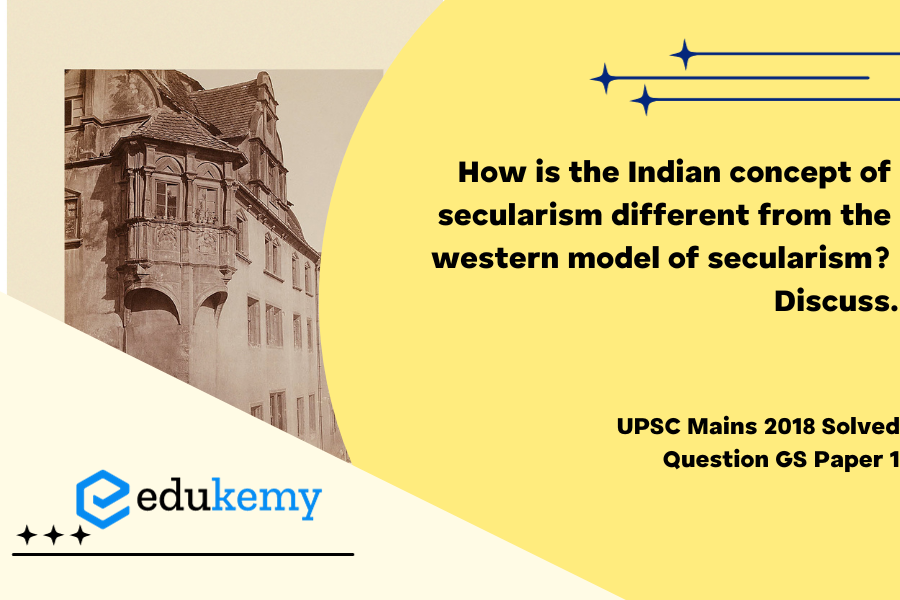The concept of secularism, a foundational principle in governance, varies significantly between India and the Western world. In the West, secularism often entails the strict separation of religion from the state, emphasizing a complete detachment of religious institutions from political authority. This model aims to ensure a neutral and impartial government that accommodates diverse beliefs. In contrast, the Indian model of secularism takes a more inclusive approach, recognizing and accommodating the country’s religious diversity. India’s secularism strives for equal respect for all religions, endorsing a policy of positive intervention by the state to safeguard the interests of religious minorities. Unlike the Western model, the Indian perspective on secularism doesn’t imply a complete separation of religion from the state apparatus; instead, it seeks to foster a harmonious coexistence of diverse faiths within the framework of a pluralistic society. This nuanced distinction reflects the unique socio-cultural context of India, where religious pluralism has deep historical roots.
Tag: Secularism.
Contents
Decoding the Question:
- In the Introduction, try to define both Western and Indian secularism.
- In Body, compare the Indian concept of secularism and the Western model of secularism.
- Conclude with the significance of secularism in a modern democracy.
Answer:
The term ‘secular’ literally means ‘worldly’ rather than ‘spiritual’, not relating to religion or bound by monastic restrictions. It means that the spheres of secularism and religion are distinct, independent, exclusive, and separate without overlapping zones.
The idea of secularism was incorporated in the Indian Constitution by the 42nd Constitutional Amendment, which amended the Preamble and declared India a secular nation. Secularism is articulated over the years throughout the political process embedded in the notions of equality and democracy, while the Western concept of secularism denies religion any space in the functioning of the state.

Difference between the Indian concept of secularism and the Western model of secularism:
| WESTERN MODEL OF SECULARISM | INDIAN MODEL OF SECULARISM |
| The State is separate from the functioning of all religious institutions and groups. | The state is neutral to all religious groups but not necessarily separate. |
| Believes in total non-interference of religion. | The principle of secularism lies in forming a positive relationship between the state and religion. |
| Does not believe in an open display of religion with an exception for places of worship. | All expressions of religion are substantiated equally with support from the state. |
| Laws are made in isolation from religious principles. | The law seeks to welcome the multiple religious principles that followers of different religions adhere to. |
| The state cannot give any financial support to educational institutions run by religious communities. | The Indian Constitution sanctions partial financial support for religious schools and the funding of religious buildings and infrastructure by the state. |
| A single uniform code of law is used to dispense justice regardless of religious background. | The law is the equivalent to all citizens; specific personal laws regarding marriage and property rights are different for every community. However, they all yielded equal consideration under the Indian Penal Code. |
| The State does not intervene in the affairs of religion till the time religion is working within the limits of the law. Example: The Western model prohibits any public policy to be drafted based on religion; therefore, the state is distanced from the religious activities and practices of its citizens. | The state shall interfere in religion to remove evils in it. Example: India has intervened by enforcing legislation against the practices of sati or widow-burning, dowry, animal and bird sacrifice, child marriage, and preventing Dalits from entering temples. |
The uniqueness of Indian secularism is that it admits the freedom of religion, unlike its Western counterpart which avoids religion. This religious freedom granted in the secular concept makes the consolidation of religious people under one umbrella a reality in India.
In case you still have your doubts, contact us on 9811333901.
For UPSC Prelims Resources, Click here
For Daily Updates and Study Material:
Join our Telegram Channel – Edukemy for IAS
- 1. Learn through Videos – here
- 2. Be Exam Ready by Practicing Daily MCQs – here
- 3. Daily Newsletter – Get all your Current Affairs Covered – here
- 4. Mains Answer Writing Practice – here


